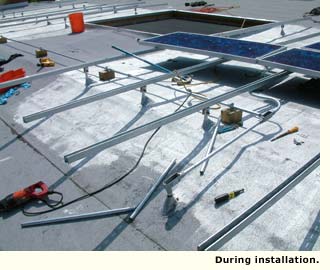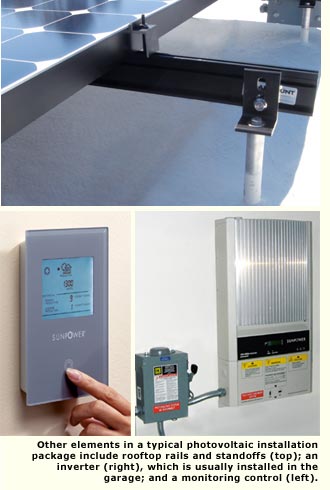Energy: Sun Power Rising - Page 2
The systems are made up of three main components: solar panels, an inverter, and a meter. Solar panels made from crystalline silicon currently account for more than 90 percent of today's solar market. Unfortunately, silicon panels remain expensive to manufacture, which is why the cost of solar arrays remains so high. The panels output 10 to 300 watts of electricity each. The number of panels a home needs depends on how much electricity the family inside requires and the power of each panel.

The inverter converts the direct current electricity (DC) into the alternating current (AC) electricity needed to run a household. Additional equipment is needed to ensure that the quality of electricity produced meets the load requirements and utility company standards.
Lastly, a meter helps a homeowner monitor the amount of power being consumed. If the utility company offers net metering, the meter can also be used to record excess electricity the PV system sends back into the grid. In this case, the meter spins forward when electricity is being drawn and backward when electricity is being produced.
Utilities that don't offer net metering require homeowners to install a second meter to track the electricity the PV system feeds into the grid. It takes two to three days for qualified solar contractors to install a typical residential system. With rebate paperwork, utility interconnection agreements, and permits, turnaround time is usually four to eight weeks.
Short of winning the lottery, many homeowners today see solar as an unattainable investment. The cost of a PV system depends on the size of the system, the quality of components, installation costs, and the local market. In simplest terms, prices are discussed in terms of dollars per watt. California solar providers report a price range of $7 to $9 per watt. A four-kilowatt (kW) system, which is the average size for residences, commonly bears a dealer price tag of between $28,000 and $36,000 installed. When state rebates and federal tax credits are factored in, that original price would be cut nearly in half. Most homes need more than four kilowatts to cover all of their electrical needs.

Although the high upfront costs of solar may intimidate many homeowners, state rebates and federal tax credits can help reduce out-of-pocket expenses. Last October, the Federal government extended the 30-percent tax credit eight years for both residential and commercial installations.
The bill eliminated a $2,000 monetary cap for residential solar projects, and it allows Alternative Minimum Tax (AMT) filers to take the credit. These solar tax credits were originally enacted in the 2005 and have created extraordinary solar electric growth in the U.S. The amount of solar electric capacity installed in 2007 was double that installed in 2006.
California Solar Initiative rebates vary according to system size, customer class, and performance and installation factors. Owners of solar systems less than 50 kilowatts may apply for an upfront cash rebate known as the Expected Performance Based Buydown (EPBB). The rebate is calculated using the expected performance of the owner's system based on equipment ratings and installation factors, such as geographic location, tilt, orientation, and shading. Customers receive their incentive payment in a lump sum after their system in fully installed and interconnected.
"Based on the current government incentives, solar is more affordable than the current cost of power," Rive says. "We hope to educate homeowners that solar is real and it's time to move in that direction. We hope that by offering economies of scale, we can bring solar to the masses."

It takes an experienced installer about 20 minutes to complete rebate paperwork for a solar installation. Typically the state cuts a check directly to the solar contractor, and the contractor cuts the rebate amount off the price of the project. On average, a 5.8-kilowatt, $46,000 solar project will generate a rebate of approximately $9,000 and a tax credit of $13,800, reducing the original sticker price to approximately $23,000.
To be eligible, owners of residences must have a Permit of Occupancy from their local Building Department prior to submitting a Reservation Request Application for California Solar Initiative incentives.




